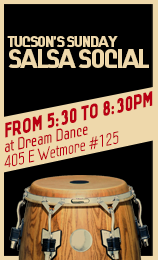History of Danzón
Danzon comes from the words Danza and Son, two other dance styles) Danzon is a dance that is tipically seen to be derived from the African Antigua regions, and originated during the XVII century and derives from 'son cubano'. Son Cubano was originally danced by the Africans of Cabo Verde in their parties and bembés. In time, it gained much popularity in the rest of the Antigua region through the many danzoneras (dance parties dedicated to danzon). During the XIX century it was also incorporated into symphonic works of various composers.
Danzon, contrary to other forms of popular dance, was an actual and precise 'date of birth'... January 1st, 1879. This was the day that Miguel Failde presented in the city of Matanzas (Cuba), his first danzon piece intitled "Las Alturas de Simpson". (The heights of Simposon). Yet it is obvious that this first danzon could not have been born and made of nothing, or no roots. It's geneological tree brings us all the way back to England, where we find country dance, which in the XVIIth century came to France, where it finally gained a lot of its popularity, though there is a slight diference in the naming of the dance: form country dance, it became contradanza. Contradanza came first to Haiti, in that time a French colony of the new world, and from there it was imported into Cuba by inhabitants that were fleeing the bloody battles and war that came to liberate the people, with its independence.
Danzón Nereidas by Ballet Folclórico de Universidad de Guadalajara
The rythym and dancing itself quickly aclimated themselves on Cuban soil to convert itself first into danza and later on as danzon; a style originally interpreted by a group called Charanga Francesa, that was basically composed of violins, percussions and flute. Danzon in Cuba then, unfortunately, experienced a period of great decline, due to certain exciting mutations of the music, which resulted in such styles as danzonete and chachacha. In order to survive as a 'popular genre' of music, danzon had to emigrate to yet another country near the Carribean, México. In fact, it is in México that the danzon, born in Cuba, continues to be taught, danced and cultivated.
The arrival of danzon on Mexican soil started through the peninsula of Yucatan, where the geographical proximity aided the exchange of musical works, which helped the musicians of the peninsula to adopt the music as their own and by the end of the past century were composing some of their own original danzon pieces. Orchestras, such as the famous Hermanos Concha organized themselves they grouped themselves during those years of intended exchange between the Yucantan peninsula and the island of Cuba. Afterwards, danzon arrived in Veracruz, where in contrast to the peninsula, it is still to this day a very important and current element in the cultural life of the jarocho city. As early as the arrival of the musical piece to the port of Veracruz, by way of the mercantile ships, the danzoneras (that was a major part of danzon) began to develop its own peculiar veracruz style. 
From the danzoneras that became to get noticed, we can name the ones of Severino and Albertico, the ones of los Chirinos Ramirez, the Danzonera Pazoz and the Banda de Mairna de Puerto, directed by Camerino Vasquez and Luis Cardona Rojas. These are the two that are responsible for instilling the customs of playing danzon in the zocalo (city center) twice a week, that became a great tradition and still take place to this day. From Veracruz, danzon emigrated to the city of México, where it evolved over the years, maintaining it freshness and popular taste, enriching the cultural history of México with salones (dance halls) like the recently ressesutated Salon México, and the more tradicional Salon Colonia Los Angeles or the California.
The iconic song of the danzon movement, is best represented by the one named 'Nereidas' which has delighted young and old (but more to the older generation) throughout the decades. Other songs include 'Almenda', 'Siboney', 'Telefono a larga distancia' etc. Dancing danzon basically consists in drawing one or two squares with the feet on the dance floor. In certain songs, the rythym accelerate and the end of the song is danced more rapidly (this without losing the style of the dance, of course) and to the rythym of son cubano. Danzon had a more aristocratic connotation or stigma attached to it than son and bolero. It rised from the original contradanza, and when it arrived in Cuba the rythym captured and was loved by the bougeois class.
It was at the end of the XIXth century when Miguel Failde, orchestra director, started to compose pieces that included and featured sincopations in the codes of danza composition, creating space for a finale that gave the chance to musicians to improvise. The orchestras were composed of musicians playing flute, violins, counterbass, piano, timbales and guiro.
The dancers created and invented new steps to address this new style of improvised danza, which in 1910 aquired its known and definate tripartite form with the piece "El Bombin de Barreto", composed by José Urfé. Whether it be in the capital city of México or in Veracruz, danzon is very important and current part of their popular music, that is still maintained as a danceable music, perhaps for its erotic elements, subtle refinement, in an era in which partner dancing (dancing as part of a couple) seemed to be disappearing.
- Login to post comments







